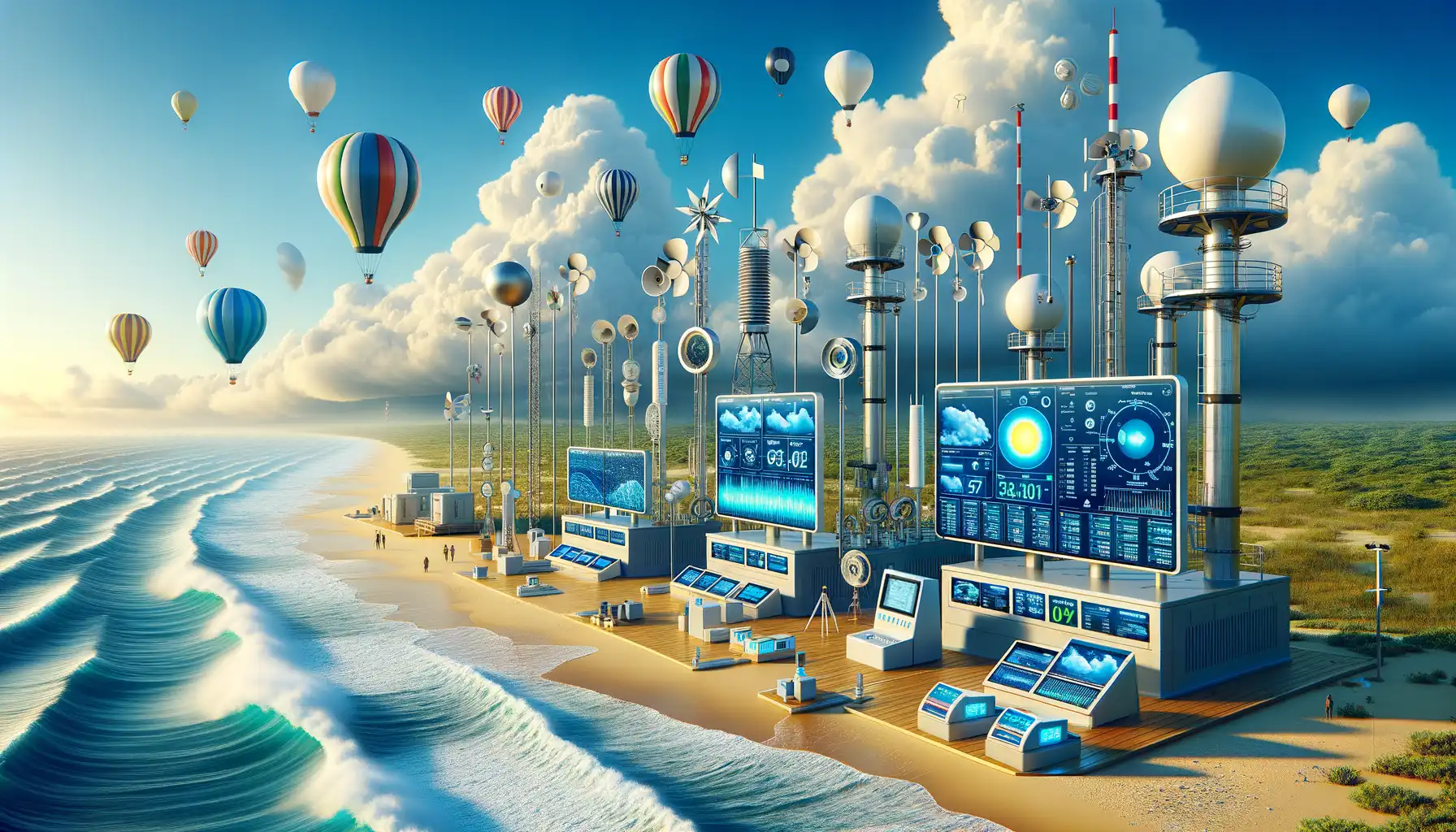Understanding the Role of AI in Weather Monitoring
How AI Transforms Weather Monitoring into Precision Art
If you’ve ever planned a day at the beach, you know the thrill of imagining golden sand and sunshine. But nature loves its surprises—sudden rain showers or unexpected gusts of wind can spoil even the best-laid plans. That’s where AI-powered weather monitoring steps in, reshaping how we predict and prepare for weather conditions.
AI doesn’t just crunch numbers; it mimics the way humans analyze patterns but at lightning speed. Imagine this: instead of scrolling through outdated forecasts, you’re tapping into systems that detect real-time shifts in cloud movements or wind direction. These systems process a treasure trove of data collected by satellites, sensors, and even smart devices—breaking it all down to deliver precise predictions directly to your phone.
- Machine learning: Teaching algorithms to recognize patterns in past weather trends.
- Neural networks: Mimicking the human brain to make sense of complex meteorological data.
- Predictive analytics: Offering tailored forecasts based on hyperlocal observations.
With this blend of science and technological magic, AI is transforming what used to feel like educated guesses into forecasts you can trust. It’s not just a tool—it’s your personal beach-day bodyguard.
Key Technologies for Real-Time Beach Weather Tracking
![]()
Advanced Sensors: The Heartbeat of Real-Time Tracking
Imagine feeling the pulse of the beach weather through cutting-edge devices—sounds magical, doesn’t it? Well, that magic begins with advanced sensors. These tiny powerhouses are placed in strategic locations across coastlines and oceans to gather real-time data. Think of them as the eyes and ears of your AI system, capturing everything from wind speed and humidity to ocean temperature.
What’s truly mesmerizing is how they work hand-in-hand with AI. For instance, a solar-powered buoy floating in the surf can constantly monitor wave heights and send updates straight to your system. It’s like having a tireless weather detective stationed at sea, reporting every subtle change in conditions.
- Weather balloons: These gentle giants ascend into the sky to track atmospheric shifts.
- Radar systems: Pinpoint storm activities and sudden rainfall patterns.
- Satellite imagery: Provides stunning visual updates of cloud movements.
Machine Learning Algorithms: The Brain Behind the Curtain
Now let’s talk about the real wizardry: machine learning. This is where raw data gets transformed into actionable insights. Your AI system doesn’t just collect information—it *learns* from it. Say, for example, your software detects a pattern of low atmospheric pressure mixed with rising sea temperatures. Using machine learning models, it can predict an incoming thunderstorm before you’ve even felt the first gust of wind.
The best part? These algorithms adapt over time, getting sharper and smarter with every passing day. It’s like teaching a friend how to surf but realizing they’ve gone on to master the waves without any more lessons. From analyzing historical weather trends to pinpointing microclimate nuances, this is where technology truly mimics human intuition—only faster and more precise.
Setting Up AI Systems for Accurate Weather Predictions

Building the Brain Behind Weather Insights
Imagine this: you’re planning the perfect beach day, but nothing ruins it faster than unpredictable weather. This is where your AI system becomes your trusty meteorological sidekick. Setting up an AI for accurate weather predictions isn’t just about plugging in code—it’s about building a digital “weather brain” that learns, adapts, and evolves like nature itself.
The first step? Feeding it data—*tons of it*. Think satellite imagery, temperature readings, tidal patterns, wind speeds, and even humidity levels. By training your AI with historical and real-time information, you’re essentially teaching it to connect the dots faster than any human ever could.
But here’s the magic: it doesn’t stop at raw numbers. AI systems rely on algorithms that mimic human intuition. Tools like deep neural networks help the system identify subtle patterns, like how a sudden drop in atmospheric pressure might hint at a storm brewing miles away.
- Hardware matters: Invest in high-performance processors to crunch complex meteorological simulations.
- Software tools: Frameworks like TensorFlow or PyTorch empower your AI to learn and adapt quickly.
- Data sources: Utilize trusted APIs from weather organizations or IoT sensors for even more precise insights.
Your AI system now isn’t just forecasting—it’s thriving, digesting the chaotic beauty of weather patterns like a beach detective on a mission to keep your plans sunny-side up.
Benefits of Using AI for Beach Weather Conditions

Why AI is a Game-Changer for Your Beach Adventures
Imagine this: you’re packing your bag for a long-awaited day at the shore—sunscreen, towel, maybe a good book. But what if you knew *exactly* when that gentle sea breeze would kick in or when those storm clouds might roll through? That’s where AI-powered beach weather tracking steps in to make your day truly carefree.
With AI crunching enormous amounts of data, it analyzes complex patterns in real-time—patterns a typical weather app might miss. Thinking about morning yoga on the sand? AI can tell you if the temperature will still be that perfect sweet spot or if you’ll need an early start to beat the heat.
- Hyper-local updates: Forget generic forecasts! AI delivers insights tailored to your beach’s exact coordinates.
- Minute-by-minute precision: Never get caught off guard again by a surprise drizzle or blistering sun.
A Personalized Forecast That Understands You
What makes AI stand out? It learns. Over time, it can recognize your behavior—like always checking wind speed for kiteboarding or UV levels for that flawless tan—and provide updates that feel as if they were crafted just for you. It’s like having your own beachside assistant, whispering tips into your ear.
What’s not to love?
Challenges and Future Possibilities in AI-Based Weather Tracking
![]()
The Roadblocks in AI Weather Tracking
AI-based weather tracking isn’t all sunshine and rainbows—storm clouds exist. For one, there’s the issue of **data quality**. Predicting beach weather in real-time demands accurate, hyper-local information, but beach environments can be surprisingly chaotic. Small shifts in wind or sudden temperature drops might throw even the smartest systems off-kilter. Without pristine datasets, AI can stumble like a surfer caught in a rogue wave.
Then there’s the challenge of **hardware limitations**. Think about it: those sleek drones monitoring the coastline or sensors buried near the sand? They require maintenance, and they aren’t cheap. Sometimes, these tools simply aren’t advanced enough to handle extremes like heatwaves or tropical storms.
Let’s not forget the ethical dilemmas. Beachgoers’ privacy matters—how do we ensure data isn’t being collected on individuals unknowingly? It’s a slippery slope.
- Balancing precision with affordability
- Developing robust systems that thrive in unpredictable weather
- Tackling concerns around privacy laws
Peeking into AI’s Horizon for Better Weather Tech
What if your beach day plans could never be ruined by surprise storms again? That future isn’t impossible! Emerging technologies like **edge computing** are poised to make predictions faster and more localized, while innovations in AI algorithms—think neural networks designed to adapt in dynamic settings—promise to boost accuracy.
Dream big: imagine smart apps that could notify surfers about ideal wave heights in real-time or provide personalized weather updates for your favorite picnic spot. These ideas might sound bold today, but so did self-driving cars once. The possibilities? Limitless.





